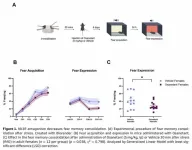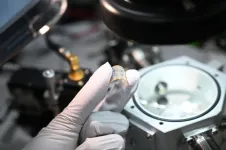(Press-News.org) A new study maps how specific lactic acid bacteria can enhance both the flavour and nutritional quality of plant-based dairy alternatives. The findings may have wide-reaching perspectives for the further development of sustainable foods.
Plant-based dairy alternatives – such as soy, oat, and almond drinks – are produced without animal ingredients for consumers seeking plant-based substitutes for milk and yoghurt. However, many of these products have the similar shortcomings: flavours that do not always appeal to consumers, and nutritional profiles that fall short of those of, e.g. cow’s milk.
A new review, led by DTU and Novonesis researchers, explores how lactic acid bacteria may help address these challenges. By analysing existing literature, the authors map how fermentation with selected bacterial strains can reduce so-called off-flavours and degrade anti-nutrients. The latter enhancing the nutrient bioavailability in plant-based dairy alternatives.
“Our review of the current research shows that fermentation with lactic acid bacteria can improve flavour perception and help make products more nutritionally complete,” says Claus Heiner Bang-Berthelsen, Senior Researcher at DTU National Food Institute.
Perspectives for more foodsa
While the study focuses specifically on plant-based dairy alternatives, the researchers believe the findings are also relevant for other food products facing similar issues. Products based on alternative protein sources such as insects, microbial proteins (e.g. mycoprotein or fermented yeast), and ingredients derived from food production side streams often face the same sensory and nutritional challenges. Fermentation with selected lactic acid bacteria may therefore prove to be a key technology in developing a wide range of sustainable foods.
“We see food fermentation as a platform technology that can support the creation of alternative foods which taste better and have higher nutritional value, allowing the use of more sustainable raw materials, says Guillermo-Eduardo Sedó Molina, PhD student at DTU National Food Institute.
For industry stakeholders, the message is clear: existing microbial solutions can improve the quality and enhance the nutritional value of plant-based products – but success depends on knowledge of bacterial strains, raw materials, and fermentation processes.
Fermentation as a key technology
Fermentation has been used for millennia to preserve and enhance foods – from sauerkraut and kefir to cheese and yoghurt. Today, it also emerges as a vital tool in developing more palatable and functional plant-based alternatives to milk.
In the new review, the researchers highlight how lactic acid bacteria – particularly those naturally adapted to plant-based raw materials – can play a pivotal role in developing plant-based fermented dairy alternatives (PBFDA).
Many plant-based ingredients naturally contain flavour compounds that consumers perceive as unpleasant – such as bitter, earthy, or green notes. These compounds – often aldehydes, ketones, and tannins – are by-products of the plant’s metabolism and can be difficult to remove without negatively affecting the rest of the product. According to the researchers, specific strains of lactic acid bacteria can convert these unwanted compounds into neutral or less perceivable flavor compounds. The result is a product that more closely resembles traditional fermented dairy products in both taste and aroma.
Key findings
Lactic acid bacteria can reduce off-flavours in plant-based fermented products.
They can degrade anti-nutritional compounds and enhance the absorption of minerals such as iron and zinc.
Lactic acid bacteria found in plants are especially well-suited to ferment plant-based milks because they have been genetically adapted to grow in plant environments.
The findings are also relevant for other alternative foods where off-flavours influence consumer acceptance, e.g. insect-based products.
Anti nutrients and mineral absorption
Another challenge with plant-based dairy alternatives is their anti-nutrient content, which negatively influences the body’s absorption of essential minerals like iron, zinc, and calcium or affects protein digestibility. Anti-nutrients bind to these minerals, making them inaccessible to the body. As a result, products may contain iron or zinc on paper but still fail to meet nutritional needs.
The researchers point out that fermentation with lactic acid bacteria can help degrade several anti-nutritional compounds. Certain bacterial strains produce enzymes that can break down these complex molecules, thereby increasing the bioavailability of nutrients in the final product.
Plant-adapted bacteria
The researchers emphasise that not all lactic acid bacteria are equally suited for this task. Bacteria originally isolated from milk are typically adapted to animal-based environments, whereas those derived from plants or plant-based foods have an evolutionary advantage in handling plant substrates. Through natural selection, these strains have developed the ability to utilise plant sugars and degrade complex plant compounds – making them ideal starter cultures for plant-based fermented products.
Therefore, the choice of bacterial strain and fermentation conditions will be crucial for developing products that are not only palatable and aromatic but also of high nutritional quality.
About the scientific review
This study is not an experimental trial with new products, but a systematic review of existing knowledge. The researchers analysed a wide range of studies and identified patterns and technological approaches that have already demonstrated promising results – and which deserve to be applied more strategically in product development.
Original title of the review: “Metabolic insights of lactic acid bacteria in reducing off-flavours and anti-nutrients in plant-based fermented dairy alternatives”
The article is published in Comprehensive Reviews in Food Science and Food Safety, March 2025.
The scientific review was funded by Agrifoodture under the research project REPLANTED. The authors come from the DTU National Food Institute and Novonesis. The technology developed in REPLANTED continues in the Agrifoodture project HyCheese, which aims to create hybrid cheeses made from milk and plants.
END
Lactic acid bacteria can improve plant-based dairy alternatives
A new study maps how specific lactic acid bacteria can enhance both the flavour and nutritional quality of plant-based dairy alternatives. The findings may have wide-reaching perspectives for the further development of sustainable foods
2025-04-08
ELSE PRESS RELEASES FROM THIS DATE:
Public housing smoking ban reduced heart attacks and strokes
2025-04-08
A new paper in Nicotine & Tobacco Research, published by Oxford University Press, finds that a 2018 U.S. ban on smoking in public housing led to a reduction in hospitalizations for cardiovascular problems.
Tobacco use and exposure to secondhand smoke is a leading cause of preventable death in the United States. Some 480,000 Americans die every year due to tobacco. While the prevalence of adults exposed to secondhand smoke decreased dramatically between 1988 and 2014 (from 87.5% to 25.2%), about 58 million non-smokers in the U.S. experience tobacco smoke, primarily at home. Beginning in the early 2000s, ...
Positron emission tomography in psychiatry: Dr. Romina Mizrahi maps the molecular future
2025-04-08
MONTRÉAL, Québec, Canada, 8 April 2025 – In a powerful and deeply reflective Genomic Press Interview, published in Brain Medicine, Dr. Romina Mizrahi, Professor of Psychiatry at McGill University and Principal Investigator of the CaTS (Clinical and Translational Sciences) Lab at the Douglas Research Center, charts a new path forward in psychiatric research—one that begins at the molecular level.
Harnessing the power of positron emission tomography (PET), Dr. Mizrahi’s work sheds light on the invisible workings of the human brain. Where traditional psychiatric diagnosis often relies on subjective symptom clusters, her approach integrates in-vivo imaging, ...
Post-trauma drug blocks fear response in female mice, study shows
2025-04-08
BARCELONA, Catalonia, Spain, 8 April 2025 – A new Brevia (peer-reviewed research report) published in Brain Medicine reveals that a single dose of the drug Osanetant, administered shortly after a traumatic event, significantly dampens fear expression in female mice. The findings provide strong preclinical support for using Nk3R antagonism as a sex-specific, time-sensitive intervention to reduce the risk of posttraumatic stress disorder (PTSD).
Targeting fear memory at its roots
Fear memory is a core feature of PTSD, especially when neutral cues become emotionally ...
Trees could be spying on illegal gold mining operations in the Amazon rainforest
2025-04-08
For hundreds of years, the Amazon has been exploited for its gold. Today, the precious metal is just as sought after, but the remaining tiny gold particles are much harder to find. Mining often happens in artisanal and small-scale mining operations that release mercury (Hg) into the air, polluting the environment and harming human health.
An international team of researchers has now examined tree rings of species native to the Peruvian Amazon to determine if trees could be used to show approximately where and when atmospheric mercury was released.
“We show that Ficus insipda tree cores can be used as a biomonitor for characterizing ...
Even after a thousand bends, performance remains uncompromised!
2025-04-08
The research team led by Dr. Jongwon Yoon, Dr. Jeongdae Kwon, and Dr. Yonghoon Kim from the Energy & Environmental Materials Research Division at the Korea Institute of Materials Science (KIMS), has successfully developed the world’s first ammonia (NH₃) gas sensor based on a copper bromide (CuBr) film that can be fabricated through a simple solution process at low temperatures. This breakthrough technology not only enables sensor flexibility, ultra-sensitivity, and high selectivity but also significantly reduces manufacturing costs.
Ammonia gas sensors detect airborne ammonia and are utilized in indoor and outdoor ...
Survey: Women’s perceptions of perimenopause
2025-04-08
Hot flashes, mood swings, weight gain and insomnia are all signs of hormonal changes and symptoms of menopause, when a woman no longer has menstrual cycles. They can also signal perimenopause, when the body is preparing for this next season of life.
“Perimenopause is when the menstrual cycle has started to change, and it is persistent,” explained Lauren Baker, DO, an obstetrics and gynecology physician at The Ohio State University Wexner Medical Center and certified practitioner with the Menopause Society. “The formal definition is periods fluctuate by at least seven days for at least 10 months.”
A new survey by Ohio State ...
Singapore scientists pioneer non-invasive 3D imaging to transform skin cancer management
2025-04-08
SINGAPORE – Researchers from the Agency for Science, Technology and Research (A*STAR) and the National Healthcare Group (NHG) have jointly pioneered an innovative imaging technique combining Multispectral Optoacoustic Tomography (MSOT) with artificial intelligence (AI) that could significantly improve the diagnosis and treatment of basal cell carcinoma (BCC), the most common form of skin cancer worldwide.
This advanced technique uses photoacoustic imaging (PAI), enhanced by an automated segmentation algorithm, to provide real-time, high-resolution, three-dimensional (3D) images of skin tumours. By accurately mapping tumour boundaries, ...
Powerful new tool promises major advances in cancer treatment
2025-04-08
New Australian technology is set to transform the way that gastrointestinal cancers are detected and treated with precise, minimally invasive surgery.
Backed by the Federal Government’s Economic Accelerator (AEA) Ignite Grant, researchers from the University of South Australia (UniSA) are using quantum technology to develop a first-of-its-kind laparoscopic probe that will allow surgeons to accurately map the spread of tumours.
The technology has the potential to improve cancer survival rates and patient quality of life worldwide.
Led by Dr Nicole Dmochowska from UniSA’s ...
Inflammation and the brain: how immune activity can alter mood and fuel anxiety
2025-04-08
FOR IMMEDIATE RELEASE
Physicians have long observed a mystifying phenomenon: After a bout of infection or an autoimmune disease flare-up, some people experience prolonged mood swings, emotional dysregulation, and changes in behavior. But the precise connection between inflammation, mood, and behavior has remained elusive.
Now, two new studies from Harvard Medical School and Massachusetts Institute of Technology, published April 7 in Cell, detail the steps of an intricate brain-immune crosstalk that accounts for this long-known but poorly understood observation.
The work, conducted ...
Researchers demonstrate the UK’s first long-distance ultra-secure communication over a quantum network
2025-04-07
Researchers have successfully demonstrated the UK’s first long-distance ultra-secure transfer of data over a quantum communications network, including the UK’s first long-distance quantum-secured video call.
The team, from the Universities of Bristol and Cambridge, created the network, which uses standard fibreoptic infrastructure, but relies on a variety of quantum phenomena to enable ultra-secure data transfer.
The network uses two types of quantum key distribution (QKD) schemes: ‘unhackable’ encryption keys hidden inside particles of light; and distributed entanglement: a phenomenon that causes quantum particles to be intrinsically ...
LAST 30 PRESS RELEASES:
Exposure to natural light improves metabolic health
As we age, immune cells protect the spinal cord
New expert guidance urges caution before surgery for patients with treatment-resistant constipation
Solar hydrogen can now be produced efficiently without the scarce metal platinum
Sleeping in on weekends may help boost teens’ mental health
Study: Teens use cellphones for an hour a day at school
After more than two years of war, Palestinian children are hungry, denied education and “like the living dead”
The untold story of life with Prader-Willi syndrome - according to the siblings who live it
How the parasite that ‘gave up sex’ found more hosts – and why its victory won’t last
When is it time to jump? The boiling frog problem of AI use in physics education
Twitter data reveals partisan divide in understanding why pollen season's getting worse
AI is quick but risky for updating old software
Revolutionizing biosecurity: new multi-omics framework to transform invasive species management
From ancient herb to modern medicine: new review unveils the multi-targeted healing potential of Borago officinalis
Building a global scientific community: Biological Diversity Journal announces dual recruitment of Editorial Board and Youth Editorial Board members
Microbes that break down antibiotics help protect ecosystems under drug pollution
Smart biochar that remembers pollutants offers a new way to clean water and recycle biomass
Rice genes matter more than domestication in shaping plant microbiomes
Ticking time bomb: Some farmers report as many as 70 tick encounters over a 6-month period
Turning garden and crop waste into plastics
Scientists discover ‘platypus galaxies’ in the early universe
Seeing thyroid cancer in a new light: when AI meets label-free imaging in the operating room
Neutrophil-to-lymphocyte ratio may aid risk stratification in depressive disorder
2026 Seismological Society of America Annual Meeting
AI-powered ECG analysis offers promising path for early detection of chronic obstructive pulmonary disease, says Mount Sinai researchers
GIMM uncovers flaws in lab-grown heart cells and paves the way for improved treatments
Cracking the evolutionary code of sleep
Medications could help the aging brain cope with surgery, memory impairment
Back pain linked to worse sleep years later in men over 65, according to study
CDC urges ‘shared decision-making’ on some childhood vaccines; many unclear about what that means
[Press-News.org] Lactic acid bacteria can improve plant-based dairy alternativesA new study maps how specific lactic acid bacteria can enhance both the flavour and nutritional quality of plant-based dairy alternatives. The findings may have wide-reaching perspectives for the further development of sustainable foods





